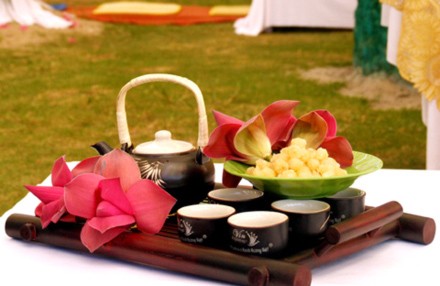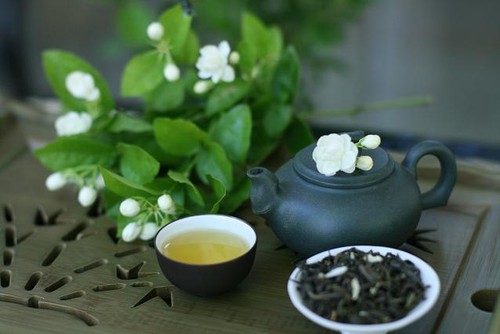(VOVworld) - Hello and welcome to this week’s edition of “Food Delight”. Vietnamese people scent their traditional tea with flowers to make it more aromatic. The flowers most often used in scented tea are lotus and jasmine, which creates a unique and intense flavor. Join us on a trip to discover the traditional ways of making and tasting lotus and jasmine tea.
Making lotus tea is time-consuming and complicated. Although, lotus flowers can be found almost anywhere in Vietnam, lotus from Hanoi’s West Lake has long been regarded as the best for scenting tea. The West Lake lotus, called “hundred-petal lotus”, has a special fragrance that lotus from other places can’t match. The lotus flowers must be picked in the early morning, when the dew is still heavy, in order to ensure the tea's freshness. Ms Nguyen Thi Tuyet, who has made lotus tea for generations, elaborates on how to scent the tea in the traditional way.
“Anthers are separated from the newly-collected flowers and then mixed with dried green tea. After two days, remove the anthers from the tea before drying the tea again in low heat. Add more anthers and continue scenting the tea. The process is repeated three times or more. It takes 100 to 120 lotus flowers to make just one gram of tea.”
 |
| Although, lotus flowers can be found almost anywhere in Vietnam, lotus from Hanoi’s West Lake has long been regarded as the best for scenting tea.(Source: doisong.vn) |
The smell of the West Lake lotus tea is special, complex, and fresh. The tea helps people relax. Another special Vietnamese scented tea is jasmine tea, which also requires special preparation. To make jasmine tea in the traditional manner, people must collect the jasmine flowers in the late afternoon or at night because that is when the flowers bloom with full fragrance. Mr Nguyen Van Quynh of Tu Lien village has been making jasmine tea for a long time. He gave us some tips on scenting the jasmine tea:
“Scenting jasmine tea is not as difficult as scenting lotus tea. We mix the new jasmine blossoms with dried green tea. You even can dry the flowers before mixing. We need 1 kilogram of jasmine flowers to scent just one kilogram of tea.”
 |
| People must collect the jasmine flowers in the late afternoon or at night because that is when the flowers bloom with full fragrance. (Source:loctancuong.com) |
While lotus tea is a specialty served only on special occasions, jasmine tea is for more frequent use. In summer’s hot weather, you can enjoy a cup of lotus tea in the restaurants and tea shops around West Lake or stop in Hang Dieu street to buy a few grams of jasmine tea. Ms Doan Thi Vinh, who is famous for selling the best-quality scented tea in Hang Dieu street, told us:
“Lotus and jasmine tea are drunk at different times. The balance and sweet smell of jasmine is very suitable for summer, while the smooth and brilliant lotus aroma suits winter’s cold weather. During the Tet holiday or others special occasions, old people like my father often invite relatives and friends to come and enjoy the scented teas. The warm atmosphere is really happy and unforgettable.”
Both types of tea reflect Vietnamese culture. Hanoians use morning dew or rain water to brew the tea because mineral water can ruin the lotus or jasmine fragrance. Some people use boiling water to clean the pot and cup before drinking. Take the right amount of tea, about 4-8gr/100ml, pour hot water and soak the tea about 4-5 minutes before enjoying. Taste our natural flower-scented tea. You will feel immersed in Vietnamese culture with every cup. Good bye. Join us next time on VOV24/7’s Food Delight.